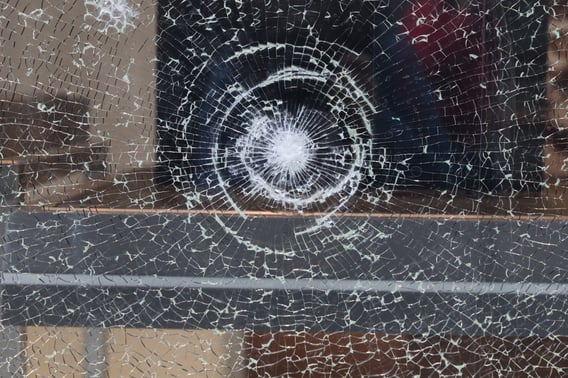 In the United States, a burglary occurs every 26 seconds. Is security glass part of your customer's security system?
In the United States, a burglary occurs every 26 seconds. Is security glass part of your customer's security system?
Every 26 seconds, a property in the US is burglarized. Home break-ins account for roughly two-thirds of these incidents, while businesses suffer the remaining one-third.
The victim loses an average of $2,500 per burglary, excluding the costs of repairing the damage they leave behind.
Shockingly, the average burglar can breach a home’s security in less than a minute. Once inside, they can spend an average of 8-12 minutes snatching valuables. Businesses that face “smash-and-grab” attacks suffer even bigger losses.
Yet there is a piece of resistance to stop this madness—security glass. When troubled by resistance, the burglar reconsiders their target. The longer it takes to break in, the louder it gets, the higher the risk of being caught.
By securing your customer's windows with security glass, you offer them a powerful security layer of protection against potential burglaries.
Discover the Right Security Glass for Your Needs
The term “security glass” describes a variety of products. However, they're not all created equal.
Common types of security glass include:
- Laminated glass
- Glass clad polycarbonate
- Polycarbonates & acrylics
- Insulated glass units
Laminated Glass
Laminated glass is created by bonding a polymer interlayer – usually polyvinyl butyral – between at least two glass plies. Its composition offers increased integrity against heavy or direct blows.
While laminated glass isn’t unbreakable, it is shatterproof glass. The plastic interlayer helps hold the glass in place when broken and provides more resistance to breakage. An intruder would have more difficulty breaking laminated glass than annealed or tempered glass.
Laminated glass is often rated for the amount of time it withstands blows before being broken through. When made with polycarbonate, laminated glass becomes much harder to break through.
What is Polycarbonate Glass?
Glass-clad polycarbonate is made by laminating a polycarbonate core between two sheets of glass. The core provides the bulk of the strength, as it is more attack-resistant. Polycarbonate sheets are up to 250 times stronger than traditional glass. Its shatterproof quality keeps it within the frame when struck by blunt objects. This means burglars must work harder to break in and are less likely to succeed.
The outer glass layer adds to the strength and longevity of the window. Polycarbonate sheets are more easily scratched than glass and don’t stand up to weathering nearly as well. Glass is also easier to clean than polycarbonate sheets, which means you don’t have to decide between strength and clarity when it comes to security windows.
“Plastic Glass” – Polycarbonate Glass vs. Acrylic Glass
Polycarbonate and acrylic sheets are thermoplastics that are often used instead of traditional glass. They offer the clarity of conventional glass and provide far more strength and durability.
These thermoplastics are commonly used in place of glass to improve security and public safety. Polycarbonate – also known as Lexan – is 250x stronger than standard glass, while acrylic – also known as Plexiglass – is 17x stronger.
While often used interchangeably, these materials are not the same. Given its strength, polycarbonate is unbreakable glass as it is used for bulletproof windows and in areas where protection from blunt impacts is necessary. Acrylics are better used in partitions, display cases, and shelving.
Insulated Glass Units
An insulated glass unit (IGU) is made with multiple panes of glass separated by a spacer, filled with air or inert gas to provide insulation, and sealed. A double-pane IGU uses two panes of glass; a triple-pane IGU uses three panes.
IGUs can be made with laminated glass on both the inboard and outboard. These added security layers make breaking into a business or home more difficult and time-consuming.
Is Tempered Glass a Type of Security Glass?
To call tempered glass “security glass” is misleading. This glass is strengthened by heating it to temperatures of more than 1,000° F before being quickly cooled. While up to 5x stronger than annealed glass, tempered glass can be fairly easily broken compared to the types mentioned above. A determined intruder will have no problem gaining entry through the tempered glass alone.
Tempered glass, or toughened glass, is better classified as safety glass. It’s less likely to cause injury as it breaks into pebble-like pieces rather than jagged shards. Because of this, tempered glass is commonly used in:
- Shower enclosures
- Skylights
- Glass walls
- Doors
- Railings
What Type of Security Glass Do You Need?
It depends. Ask yourself:
- What am I trying to secure?
- How much can I afford?
- How high is the local crime rate?
- What types of crime are most common near me?
- Is this an outdoor or indoor project?
A retail storefront, a school, and a home may require different security measures. The idea is to make it very difficult to break through the window. Often, if a perpetrator can’t break the glass enough to create an entry point, they’ll leave the scene or try to find another way.
Need help deciding which glass option will meet your customer's security needs? Contact us today:






